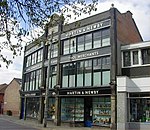Ipswich Blackfriars was a medieval religious house of Friars-preachers (Dominicans) in the town of Ipswich, Suffolk, England, founded in 1263 by King Henry III and dissolved in 1538. It was the second of the three friaries established in the town, the first (before 1236) being the Greyfriars, a house of Franciscan Friars Minors, and the third the Ipswich Whitefriars of c. 1278–79. The Blackfriars were under the Visitation of Cambridge.
The Blackfriars church, which was dedicated to St Mary, disappeared within a century after the Dissolution, but the layout of the other conventual buildings, including some of the original structures, survived long enough to be illustrated and planned by Joshua Kirby in 1748. By that time later uses had supervened and their interpretation had become confused. The last of the monastery buildings, the former sacristy, chapter house and dormitory, continued in use as a schoolroom for the Ipswich School until 1842 before finally being demolished in 1849. In 1898 Nina Layard had some success in locating buried footings. A modern understanding of the site emerged during the 1970s and 1980s, through scholarly interpretation and in excavations by the Suffolk County Council team, by which the position of the lost Blackfriars church was recognized and revealed, much of the original plan was clarified or confirmed, and former misapprehensions were corrected.The site of the Blackfriars church, between Foundation Street and Lower Orwell Street, is preserved as an open grassed recreation area where the footings of the building and a surviving fragment of the wall of the sacristy can be seen, and are explained by interpretative panels. A modern housing development covers the site of the lost conventual buildings.










